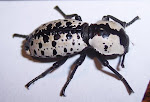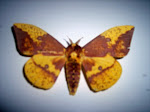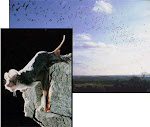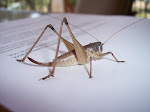Issue 10 - November 12, 2009 Texas Red Headed Centipede
Indulge me here for a moment and let me tell a little story. I’ll get to the point shortly.
A few months ago at about 1:00 a.m., that time of the night when I’m sleeping the soundest, I was awakened by a loud scream of “Dad! DAAAAD!”. Now all you fathers out there will know that this is a worse nightmare than Nancy Pelosi. Nothing is more disconcerting to a father than having one of your children scream in panic, and when you are woken up from a deep sleep fear launches you into action. The adrenalin rush clears the cobwebs in about two seconds, and I’m up and rushing through the dark toward the other side of the house. Mind you that I’m naked as a jaybird and armed to the teeth by this time.
Anyway, just about when I realize that the alarm system didn’t go off, I meet my 20 year old son running toward me from my wife’s office. He’s half hysterical as I push by him and I pick up on words like ‘Come …… Look ….. Over there …….. Foot …… I don’t know what ….’. The only light in this room is from the glow of the computer screen where my son was sitting, so I flick on the ceiling light and look around. I caught a glimpse of something quick and dark slither under the door into the adjacent bathroom. I breathed a sigh of relief, laid the gun down (it’s heavy and I don’t want to blow holes in our new tiles) and eased the bathroom door open. What I see is a sinister looking creature about eight inches long scrambling along the baseboard. I had never seen anything like this before, and was a little taken back, but I reached over to grab it…….
I just had my first encounter with the Texas Red Headed Centipede.
(Kingdom; Animalia, Phylum; Arthropoda, Class; Chilopoda, Order; Scolopendromorpha, Family; Scolopendridae, Genus: Scolopendra, Species: S. Heros)
I love our wildlife here in Mystic Shores, I surely do, but I hate these damn things and I take them as proof positive that God has a sense of humor. Why else would He create the Texas Red Headed Centipede? They are scary, creepy, fast, elusive and poisonous, with a fierce and aggressive personality to match.
These little monsters are the largest of the many-legged centipedes and millipedes in the Hill Country, and often reach lengths of 6-8 inches. The centipedes, incidentally, are distinguished from millipedes by having a single pair of legs per segment and the legs come off the side. Our Texas Red Headed version has 20 pairs of bright yellow legs followed by a 21st pair of modified legs at the rear end that are black with yellow tips. (Interestingly, all of the three thousand or so different species of centipedes have an odd number of pairs of legs. You will find them with 15 pairs of legs, 21 pairs, 23 pairs etc. but never 22 or 24 etc.) It is also interesting to note that each pair of legs is slightly longer than the set immediately in front of it. This helps them avoid tripping over their own feet when they move swiftly. There is no ‘stinger’ at the tail end but the front end is all business.
The head and first two segments are chestnut red and this contrasts sharply with the black body and yellow legs. The biologists call this coloration ‘aposematic’ and it supposedly serves as a warning to predators that this critter is poisonous and is not to be trifled with. If you look closely at the picture above, you will see two appendages that curve around the mouth area. They are red with black tips and are called ‘forcipules’, or venom claws, or venom fangs, or maxillipeds. These are used to grasp prey (or a finger if you are not careful) and inject venom from poison glands at the base of the fang. The grip is quite strong and a full grown Texas Red Headed Centipede can pierce work gloves. (I know this from very recent personal experience!) The venom, however, is not very powerful and centipede bites are typically more painful for humans than they are dangerous. The pain normally subsides after about 15 minutes and localized swelling disappears after about three hours. In the event of a severe reaction or if you have other insect allergies, emergency medical services should be contacted immediately.
The Texas Red Headed Centipede, also known as the Giant Redheaded Centipede, is found in other nearby states and northern Mexico as well as Texas. It seems fairly common in parts of Arkansas. Within these habitats, centipedes prefer a moist micro-environment because they lack the waxy cuticle found on insects and spiders that help them to retain moisture. Damp rotted logs, or thick leaf litter are preferred spots for centipedes to hide and hunt during their nightly forays.
They are ferocious little predators and feed mostly on invertebrates which they locate with their long antennae. Texas Red Headed Centipedes, because of their size, have also been known to feed on small toads and snakes. In captivity, they seem to prefer moths.
Sex for a Texas Red Headed Centipede doesn’t involve mating. The male leaves a spermatophore lying around for the female to take up. Although this seems a rather unromantic and random method of reproducing, it apparently is effective because centipedes have been around over 400 million years. Anyway, after laying between 15 and 60 eggs in a hole in a rotted log, the female curls around the egg mass and protects and grooms the eggs from fungi until they hatch. They are born in late spring/early summer and, except for their color, they look like miniature adults. There is one downside to being a centipede mother: some species of Scolopendra are matriphagic, meaning that the offspring eat the mother. The young molt and shed their exoskeleton as they grow and it may be a year before they become sexually mature. In general they are long lived creatures, compared to insects for example, and centipedes can live for a few years.
The one that ran over my son’s bare foot late that night while he was sitting at the computer didn’t live for a long time. I grabbed it and threw it into the commode before he had a chance to bite me. My last view of the first Texas Red Headed Centipede that I ever encountered, was as he was swirling down the toilet. Good place for ‘em.
Clay
Click on these pictures to go directly to the article.
Followers
Blog Archive
About Me

- Clay Crum
- I'm always looking for suggestions (or photos) about other Mystic Shore wildlife. Do you know where a rattlesnake den is located? Do you have pictures of a mountain lion taken locally? Have you had interesting encounters with our wildlife? Share them with me by sending me an email or commenting on this blog.













